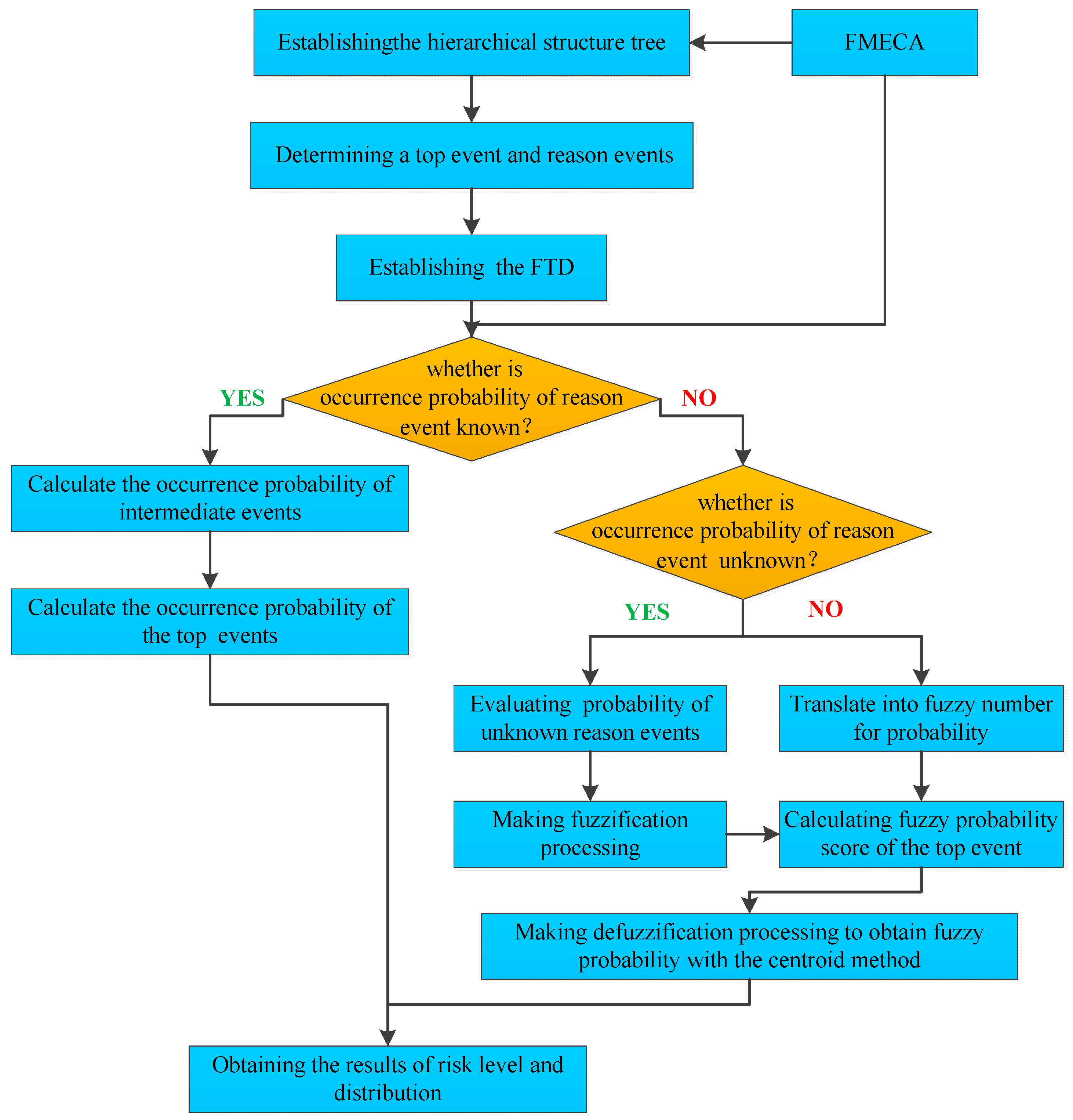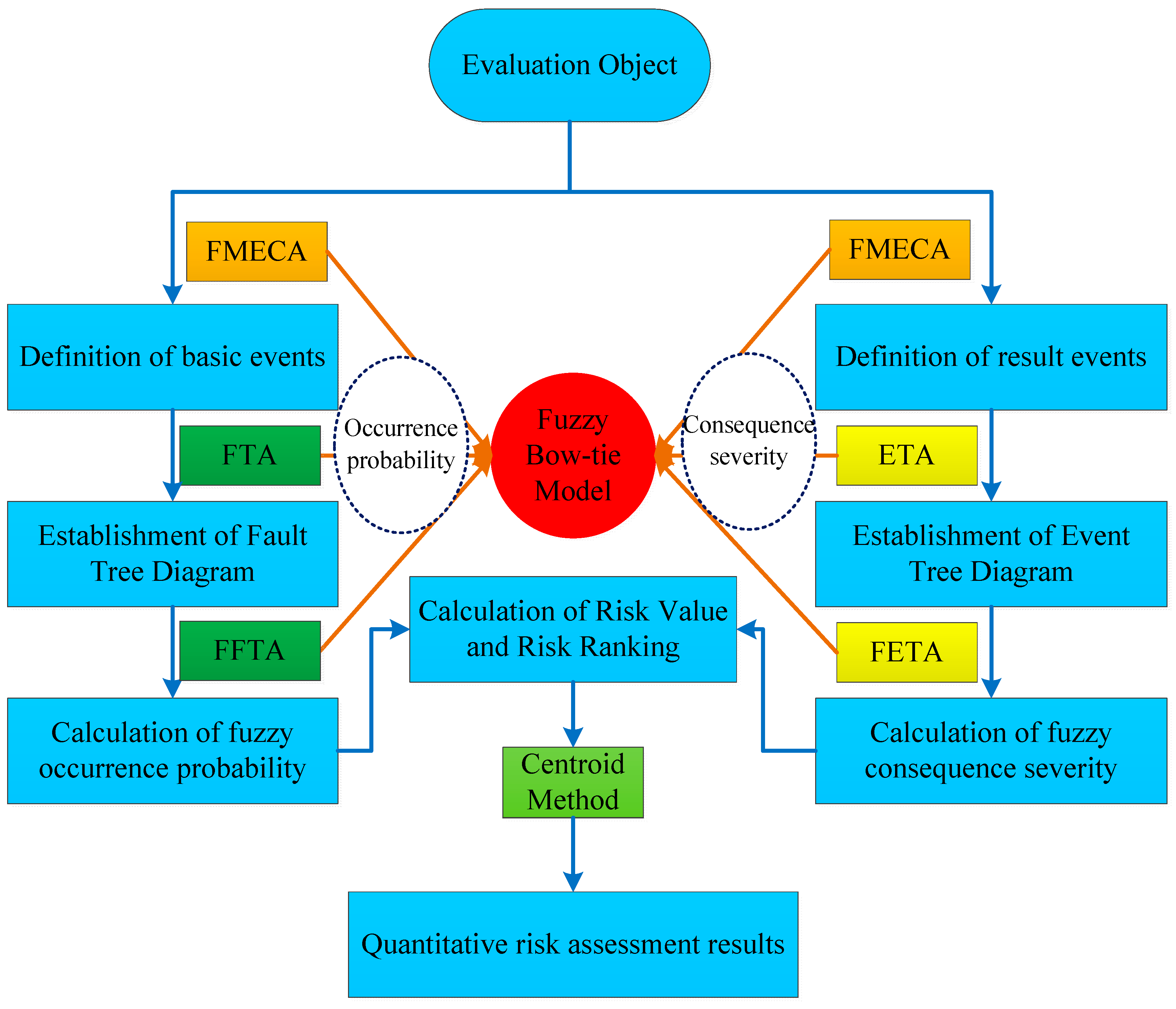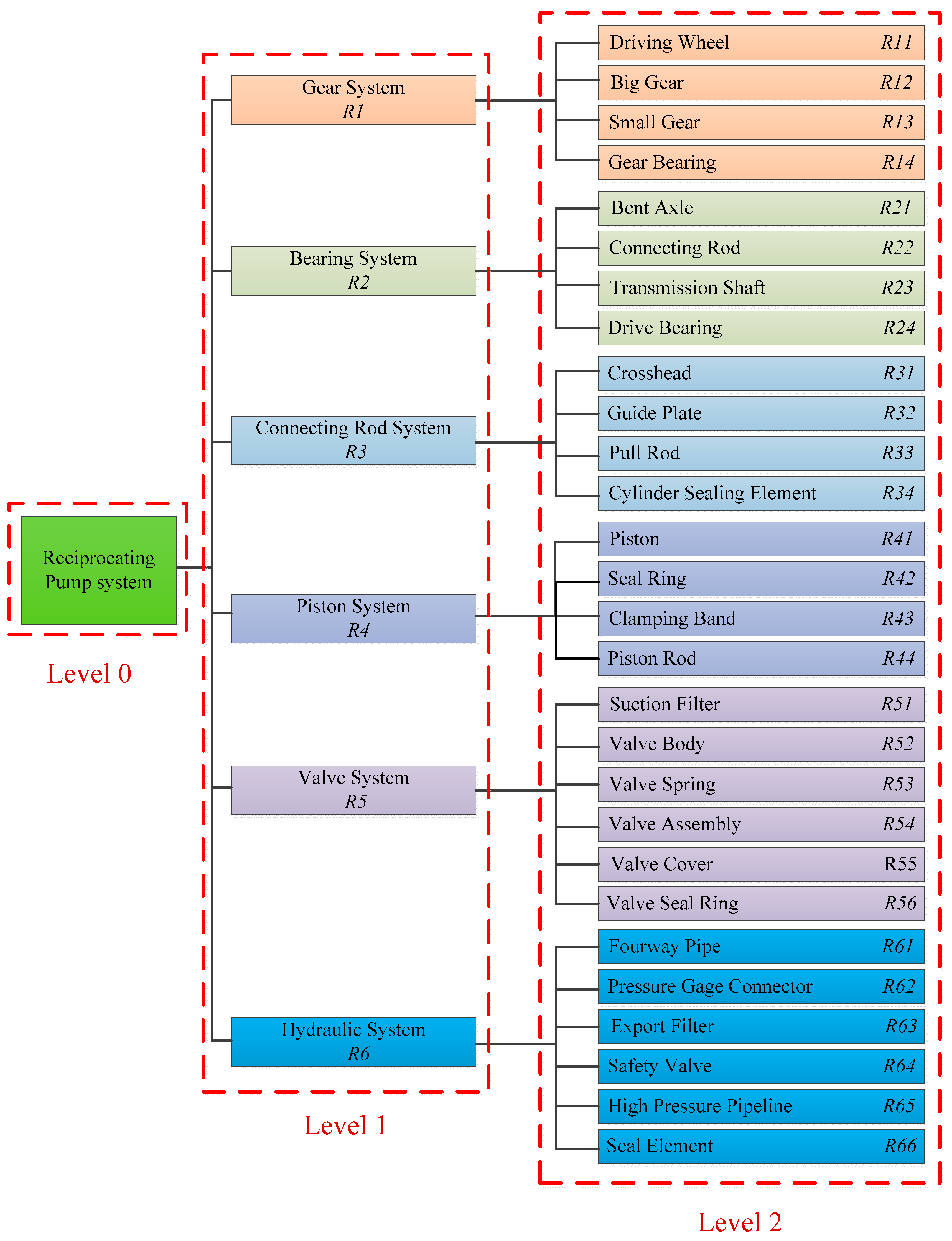A Quantitative Risk Analysis Method for the High Hazard Mechanical System in Petroleum and Petrochemical Industry
Abstract
:1. Introduction
2. Conventional Risk Analysis Methods for Mechanical Systems
2.1. FMECA
2.2. Fault Tree Analysis
2.3. Event Tree Analysis
2.4. Bow-Tie Model
3. Study on a Quantitative Risk Analysis Method for HHMS
3.1. Establishing a Hierarchical Structure Tree
3.2. Study on a Data Processing Method for Hybrid Data
3.2.1. Triangular Fuzzy Number
3.2.2. Method for Fuzzification and Defuzzification
3.2.3. Fuzzy Method for a Crisp Number
3.3. Study on a Fuzzy Fault Tree Analysis
- Step 1:
- Establish a HST. The complex structural composition is analyzed for the HHMS.
- Step 2:
- Perform a FMECA. A FMECA report is obtained that provides risk analysis data for follow-up analysis.
- Step 3:
- Determine a top event and establish a FTD. For the top event determined, a set of related reason events is obtained from the FMECA report. A FTD can be constructed with the FTA.
- Step 4:
- Judge if all reason events are known. If the answer is true (YES), proceed to the next step. Otherwise (NO), jump to Step 7. This step determines the data type in the FTD. All reason events are divided into two types based on their data types: known reason events and unknown reason events. The OP of the known reason event is a crisp number, and an unknown reason event is subjective language.
- Step 5:
- Obtain crisp number of the OP of all reason events.
- Step 6:
- Calculate the OP of top event. In this step, the Probability Statistics method is used to calculate the probability of top event.
- Step 7:
- Judge whether all reason events are unknown. If it is true (YES), jump to Step 9. Otherwise (NO), go on to the next step.
- Step 8:
- Transform crisp numbers into fuzzy numbers. The fuzzy method for crisp numbers is applied to complete this process.
- Step 9:
- Evaluate the OP of unknown reason events. The qualitative evaluation and description obtained from opinions of the reviewers is handled with standard fuzzy semantics for the OP of unknown reason events.
- Step 10:
- Perform the fuzzification process with TFN. The fuzzy semantics obtained are transformed into fuzzy numbers based on the fuzzy transformation results in Table 1. To ensure the reasonableness of the result, the FOP should be integrated based on the opinions of a number of reviewers.
- Step 11:
- Calculate the FOP of the top event. The fuzzy numbers of the OP are converted into a fuzzy probability score using Equation (11) or Equation (12).
- Step 12:
- Perform the defuzzification process with the Centroid Method. The FOP of the top event is obtained from the fuzzy probability score of the top event with the Centroid Method.
- Step 13:
- Obtain the risk level and distribution results. By analyzing and explaining the results, the risk level and distribution in the HHMS are obtained.
3.4. Study on a Fuzzy Event Tree Analysis
- Step 1:
- Determine an initial event and constructing its ETD with ETA. For an initial identified event, a set of possible intermediate events and result events can be obtained for the FMECA report, and the ETD is established by the ETA.
- Step 2:
- Judge whether the initial event and its result events are known at the first event node, namely, the possibility of every event being a crisp number should be confirmed. If it is true (YES), then proceed Step 3. Otherwise (NO), proceed to Step 4.
- Step 3:
- Define and calculate occurrence probability with crisp numbers. The probability of the result event at one event node is defined by crisp numbers and calculated with the conventional rule, like Equation (15). Then, jump to Step 7.
- Step 4:
- Define occurrence probability with fuzzy numbers. The possibility of all events relating to this result event before the event node is fuzzed with the TFN. The quantitative values of their occurrence possibility are obtained by transformation from the qualitative evaluation result. Moreover, all crisp numbers are transformed into fuzzy numbers.
- Step 5:
- Calculate the fuzzy probability score. The fuzzy numbers of the CS of the result events are converted into the fuzzy consequence severity (FCS) of the result events with Equation (16).
- Step 6:
- Perform defuzzification process. The CS of the result events are obtained from the FCS using the Centroid Method.
- Step 7:
- Judge if the result events are the final result events. If true (YES), proceed to Step 8. Otherwise (NO), proceed to Step 2.
- Step 8:
- Analyze and explain the results.The specific flow chart of the FETA is shown in Figure 4, based on the calculation steps.
3.5. Study of a Fuzzy Bow-Tie Model
4. Case Study
5. Conclusions
Acknowledgments
Author Contributions
Conflicts of Interest
Abbreviations
| AIM | Asset Integrity Management |
| BN | Bayesian network |
| BTM | Bow-tie Model |
| CA | Criticality Analysis |
| CS | Consequence severity |
| CCS | Consequence severity ranking |
| DNV | Det Norske Veritas |
| ETA | Event tree analysis |
| ETD | Event Tree Diagram |
| HHMS | High hazard mechanical system |
| HST | Hierarchical structure tree |
| FFTA | Fuzzy fault tree analysis |
| FETA | Fuzzy event tree analysis |
| FBTM | Fuzzy bow-tie model |
| FFTA | Fuzzy Fault Tree Analysis |
| FMECA | Failure mode effects and criticality |
| FOP | Fuzzy occurrence probability |
| FTA | Fault tree analysis |
| FTD | Fault Tree Diagram |
| FRP | Fuzzy risk priority |
| FST | Fuzzy Set Theory |
| OP | Occurrence probability |
| OPR | Occurrence probability ranking |
| PHM | Prognostic and Health Management |
| PM | Periodical Maintenance |
| PPI | Petroleum and petrochemical industry |
| RPS | Reciprocating pump system |
| RPN | Risk Priority Number |
| RR | Risk ranking |
| SLV | Subjective language variables |
| TFN | Triangular fuzzy number |
| UVD | Uncertain and vague data |
References
- Landucci, G.; Necci, A.; Antonioni, G.; Argenti, F.; Cozzani, V. Risk assessment of mitigated domino scenarios in process facilities. Reliab. Eng. Syst. Saf. 2017, 160, 37–53. [Google Scholar] [CrossRef]
- Landucci, G.; Paltrinieri, N. A methodology for frequency tailorization dedicated to the Oil & Gas sector. Process Saf. Environ. Prot. 2016, 104, 123–141. [Google Scholar]
- Goerlandt, F.; Khakzad, N.; Reniers, G. Validity and validation of safety-related quantitative risk analysis: A review. Saf. Sci. 2017, 99, 127–139. [Google Scholar] [CrossRef]
- Xu, K.; Tang, L.C.; Xie, M.; Ho, S.L.; Zhu, M.L. Fuzzy assessment of FMEA for engine systems. Reliab. Eng. Syst. Saf. 2002, 75, 17–29. [Google Scholar] [CrossRef]
- Brandsæter, A. Risk assessment in the offshore industry. Saf. Sci. 2002, 40, 231–269. [Google Scholar] [CrossRef]
- Shahriar, A.; Sadiq, R.; Tesfamariam, S. Risk analysis for oil & gas pipelines: A sustainability assessment approach using fuzzy based bow-tie analysis. J. Loss Prev. Process Ind. 2012, 25, 505–523. [Google Scholar]
- Ferdous, R.; Khan, F.; Sadiq, R.; Amyotte, P.; Veitch, B. Fault and event tree analyses for process systems risk analysis: Uncertainty handling formulations. Risk Anal. Int. J. 2010, 31, 86–107. [Google Scholar] [CrossRef] [PubMed]
- Ferdous, R.; Khan, F.; Sadiq, R.; Amyotte, P.; Veitch, B. Analyzing system safety and risks under uncertainty using a bow-tie diagram: An innovative approach. Process Saf. Environ. Prot. 2013, 91, 1–18. [Google Scholar] [CrossRef]
- Goerlandt, F.; Reniers, G. On the assessment of uncertainty in risk diagrams. Saf. Sci. 2016, 84, 67–77. [Google Scholar] [CrossRef]
- Landucci, G.; Bonvicini, S.; Cozzani, V. A methodology for the analysis of domino and cascading events in Oil & Gas facilities operating in harsh environments. Saf. Sci. 2017, 95, 182–197. [Google Scholar]
- Scorsetti, M.; Signori, C.; Lattuada, P.; Urso, G.; Bignardi, M.; Navarria, P.; Trucco, P. Applying failure mode effects and criticality analysis in radiotherapy: Lessons learned and perspectives of enhancement. Radiother. Oncol. 2010, 94, 367–374. [Google Scholar] [CrossRef] [PubMed]
- Tchorzewska-Cieslak, B. A fuzzy model for failure risk in water-pipe networks analysis. Ochr. Srodowiska 2011, 33, 35–40. [Google Scholar]
- Goerlandt, F.; Reniers, G. An approach for reconciling different perspectives and stakeholder views on risk ranking. J. Clean. Prod. 2017, 149, 1219–1232. [Google Scholar] [CrossRef]
- Chevreau, F.R.; Wybo, J.L.; Cauchois, D. Organizing learning processes on risks by using the bow-tie representation. J. Hazard. Mater. 2006, 130, 276–283. [Google Scholar] [CrossRef] [PubMed]
- Markowski, A.S.; Mannan, M.S.; Bigoszewska, A. Fuzzy logic for process safety analysis. J. Loss Prev. Process Ind. 2009, 22, 695–702. [Google Scholar] [CrossRef]
- Landucci, G.; Antonioni, G.; Tugnoli, A.; Bonvicini, S.; Molag, M.; Cozzani, V. HazMat transportation risk assessment: A revisitation in the perspective of the Viareggio LPG accident. J. Loss Prev. Process Ind. 2017, 49, 36–46. [Google Scholar] [CrossRef]
- Yaghoubpour, Z.; Givehchi, S.; Tabrizi, M.A.; Masoudi, F.; Nourian, L. Public transport risk assessment through FTA. Int. J. Hum. Cap. Urban Manag. 2016, 1, 93–102. [Google Scholar]
- Sun, S.; Kensek, K.; Noble, D.; Schiler, M. A method of probabilistic risk assessment for energy performance and cost using building energy simulation. Energy Build. 2016, 110, 1–12. [Google Scholar] [CrossRef]
- American Institute of Chemical Engineers (AIChE). Guidelines for Chemical Process Quantitative Risk Analysis, 2nd ed.; AIChE: New York, NY, USA, 2000. [Google Scholar]
- Tchorzewska-Cieslak, B.; Boryczko, K.; Eid, M. Failure scenarios in water supply system by means of fault tree analysis. In Proceedings of the Advances in Safety, Reliability and Risk Management, Troyes, France, 18–22 September 2011. [Google Scholar]
- Ferdous, R.; Khan, F.; Sadiq, R.; Amyotte, P.; Veitch, B. Handling data uncertainties in ETA. Process Saf. Environ. Prot. 2009, 87, 283–292. [Google Scholar] [CrossRef]
- De Barros, L.C.; Bassanezi, R.C.; Lodwick, W.A. Fuzzy Sets Theory and Uncertainty in Mathematical Modeling. In A First Course in Fuzzy Logic, Fuzzy Dynamical Systems, and Biomathematics; Springer: Berlin/Heidelberg, Germany, 2017; pp. 1–21. [Google Scholar]
- Senol, Y.E.; Sahin, B. A novel real-time continuous fuzzy fault tree analysis (RC-FFTA) model for dynamic environment. Ocean Eng. 2016, 127, 70–81. [Google Scholar] [CrossRef]
- Tchórzewska-Cieslak, B.; Boryczko, K.; Piegdon, I. Possibilistic risk analysis of failure in water supply network. In Safety and Reliability: Methodology and Applications, Proceedings of the European Safety and Reliability Conference, Wroclaw, Poland, 14–18 September 2014; CRC Press: Boca Raton, FL, USA, 2014; pp. 1473–1480. [Google Scholar]
- Sadiq, R.; Saint-Martin, E.; Kleiner, Y. Predicting risk of water quality failures in distribution networks under uncertainties using fault-tree analysis. Urban Water J. 2008, 5, 287–304. [Google Scholar] [CrossRef]
- Landucci, G.; Argenti, F.; Tugnoli, A.; Cozzani, V. Quantitative assessment of safety barrier performance in the prevention of domino scenarios triggered by fire. Reliab. Eng. Syst. Saf. 2015, 143, 30–43. [Google Scholar] [CrossRef]








| SN | Occurrence Probability | Consequence Severity | Membership Function |
|---|---|---|---|
| 1 | Very low (VL) | Slight (SL) | (0.00, 0.00, 0.25) |
| 2 | Low (L) | Minor (MI) | (0.00, 0.25, 0.50) |
| 3 | Medium (M) | Moderate (MO) | (0.25, 0.50, 0.75) |
| 4 | High (H) | Critical (CR) | (0.50, 0.75, 1.00) |
| 5 | Very high (VH) | Catastrophic (CA) | (0.75, 1.00, 1.00) |
| Failure of Level 2 Components | FOP | FCS | FRP |
|---|---|---|---|
| Driving Wheel | (0.3245, 0.4257, 0.5483) | (0.8712, 0.7954, 0.6854) | (0.2827, 0.3386, 0.3758) |
| Big Gear | (0.1245, 0.2537, 0.3545) | (0.9754, 0.8745, 0.6587) | (0.1214, 0.2219, 0.2335) |
| Small Gear | (0.2354, 0.3547, 0.4538) | (0.9654, 0.8642, 0.6628) | (0.2273, 0.3065, 0.3008) |
| Gear Bearing | (0.3578, 0.4562, 0.5578) | (0.6587, 0.5398, 0.4257) | (0.2357, 0.2463, 0.2375) |
| Bent Axle | (0.0985, 0.1256, 0.2357) | (0.9534, 0.8218, 0.6275) | (0.0939, 0.1032, 0.1479) |
| Connecting Rod | (0.1253, 0.2387, 0.3654) | (0.8542, 0.7628, 0.6645) | (0.1070, 0.1821, 0.2428) |
| Transmission Shaft | (0.1364, 0.2497, 0.3434) | (0.7865, 0.7241, 0.5948) | (0.1073, 0.1808, 0.2043) |
| Drive Bearing | (0.2876, 0.3587, 0.4987) | (0.6245, 0.5102, 0.4112) | (0.1796, 0.1830, 0.2051 |
| Crosshead | (0.6159, 0.7301, 0.9000) | (0.6250, 0.4375, 0.2500) | (0.3849, 0.3115, 0.2230) |
| Guide Plate | (0.6059, 0.7119, 0.9020) | (0.6361, 0.4264, 0.2500) | (0.3854, 0.3036, 0.2255) |
| Pull Rod | (0.1148, 0.2225, 0.3945) | (0.6455, 0.4432, 0.2612) | (0.0741, 0.0986, 0.1030) |
| Cylinder Sealing Element | (0.6219, 0.7285, 0.9110) | (0.1254, 0.1025, 0.0250) | (0.0780, 0.0747, 0.0228) |
| Piston | (0.6124, 0.7052, 0.8831) | (0.6200, 0.5400, 0.4600) | (0.3797, 0.3808, 0.4062) |
| Seal Ring | (0.6320, 0.7171, 0.9012) | (0.2500, 0.2500, 0.2500) | (0.1580, 0.1793, 0.2253) |
| Cylinder Liner | (0.6146, 0.7009, 0.8612) | (0.5000, 0.5000, 0.5000) | (0.3073, 0.3504, 0.4306) |
| Piston Rod | (0.1154, 0.2114, 0.3930) | (0.6500, 0.5500, 0.5200) | (0.0750, 0.1163, 0.2044) |
| Suction Filter | (0.1575, 0.2245, 0.3945) | (0.6500, 0.5300, 0.4500) | (0.1024, 0.1190, 0.1775) |
| Valve Body | (0.3219, 0.4185, 0.5680) | (0.6227, 0.5724, 0.4300) | (0.2004, 0.2395, 0.2442) |
| Valve Spring | (0.4427, 0.5245, 0.6765) | (0.5000, 0.5000, 0.5000) | (0.2213, 0.2622, 0.3383) |
| Valve Assembly | (0.3112, 0.4024, 0.5245) | (0.4800, 0.4500, 0.4300) | (0.1494, 0.1811, 0.2255) |
| Valve Cover | (0.1857, 0.2872, 0.4022) | (0.5000, 0.5000, 0.5000) | (0.0929, 0.1436, 0.2011) |
| Valve Seal Ring | (0.5648, 0.6421, 0.7812) | (0.7854, 0.6245, 0.5378) | (0.4436, 0.4010, 0.4201) |
| Fourway Pipe | (0.0157, 0.0367, 0.0978) | (0.7743, 0.6356, 0.5378) | (0.0122, 0.0233, 0.052) |
| Pressure Gage Connector | (0.1246, 0.2124, 0.2987) | (0.6215, 0.4521, 0.2500) | (0.0774, 0.0960, 0.0747) |
| Export Filter | (0.1578, 0.2441, 0.3375) | (0.8021, 0.7524, 0.6521) | (0.1266, 0.1837, 0.2201) |
| Safety Valve | (0.1354, 0.2257, 0.3045) | (0.8541, 0.7998, 0.6845) | (0.1156, 0.1805, 0.2084) |
| High Pressure Pipeline | (0.0058, 0.0158, 0.0598) | (0.6326, 0.4410, 0.2500) | (0.0037, 0.0070, 0.015) |
| Seal Element | (0.1424, 0.2612, 0.3187) | (0.7854, 0.6245, 0.5378) | (0.1118, 0.1631, 0.1714) |
© 2017 by the authors. Licensee MDPI, Basel, Switzerland. This article is an open access article distributed under the terms and conditions of the Creative Commons Attribution (CC BY) license (http://creativecommons.org/licenses/by/4.0/).
Share and Cite
Tang, Y.; Jing, J.; Zhang, Z.; Yang, Y. A Quantitative Risk Analysis Method for the High Hazard Mechanical System in Petroleum and Petrochemical Industry. Energies 2018, 11, 14. https://doi.org/10.3390/en11010014
Tang Y, Jing J, Zhang Z, Yang Y. A Quantitative Risk Analysis Method for the High Hazard Mechanical System in Petroleum and Petrochemical Industry. Energies. 2018; 11(1):14. https://doi.org/10.3390/en11010014
Chicago/Turabian StyleTang, Yang, Jiajia Jing, Zhidong Zhang, and Yan Yang. 2018. "A Quantitative Risk Analysis Method for the High Hazard Mechanical System in Petroleum and Petrochemical Industry" Energies 11, no. 1: 14. https://doi.org/10.3390/en11010014




